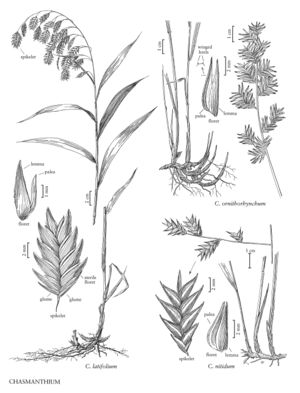Difference between revisions of "Chasmanthium ornithorhynchum"
FNA>Volume Importer |
FNA>Volume Importer |
(No difference)
| |
Revision as of 19:21, 24 September 2019
Culms 35-40(90) cm, 0.8-1 mm thick at the nodes, rarely branched, leafy for 80% of their height. Sheaths glabrous; collars pilose; ligules 0.2-0.3 mm, irregularly laciniate; blades 7-9(15) cm long, 3.5-6 mm wide, lanceolate-fusiform, glabrous adaxially. Panicles (2.5)5-10.5(12) cm, open, erect; branches divergent, sometimes strongly so; axils of panicle branches pilose; pedicels 0.5-1 mm. Spikelets 9.5-12 mm long, 11-17(18) mm wide, with (4)5-10 florets, lower 2-4 florets sterile, fertile florets divergent to 85°. Lower glumes 2.5-2.9 mm, 2-3-veined; upper glumes 2.6-3.6 mm, 3-5-veined; calluses glabrous; fertile lemmas 5.8-9.3 mm, straight, (9)11-13-veined, keels not winged, scabrous to scabridulous distally; paleas 7.2-9 mm; anthers 1.1-1.9 mm, the length invariant within a spikelet. Caryopses 2-3 mm, enclosed at maturity. 2n = 24.
Distribution
N.C., S.C., Fla., Ala., Miss., La.
Discussion
Chasmanthium ornithorhynchum grows along stream and river banks in low woods, and on hummocks in swamps. It is most common along the coastal plain from eastern Louisiana to western Florida, but is also found at a few other locations in the south¬eastern United States.
Selected References
None.
